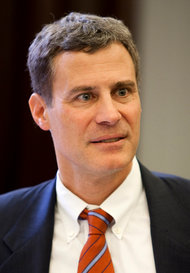10:49 a.m. | Updated
The covert data miners at the National Security Agency stole the thunder of the more predictable number crunchers at the Bureau of Labor Statistics on Friday morning, when the release of the May jobs numbers drew merely a low rumble. The economy added 175,000 jobs last month, slightly more than expected, but the unemployment rate ticked up to 7.6 percent.
The numbers offer a “modest relief,” said Ian Shepherdson, the chief economist at Pantheon Macroeconomics, a market intelligence firm. He predicted in an e-mail, however, that the numbers in June and July would be “materially weaker than May,” adding, “Talk of tapering will not be quieted by this report but still seems premature.”
Alan B. Krueger, the chairman of the White House Council of Economic Advisers, saw nothing but good news in the report: “While more work remains to be done, today’s employment report provides further confirmation that the U.S. economy is continuing to recover from the worst downturn since the Great Depression.”
Posting on the White House blog, Mr. Krueger defended the increase in the unemployment rate to 7.6 percent from 7.5 percent by noting an increase in the labor participation rate, “a sign that more workers felt encouraged to search for a job.”
But another liberal economist, Adam S. Hersh of the Center for American Progress, was less impressed:
It’s unclear whether Reince Priebus, the Republican Party chairman, intended to create a little rhyme, but here is the first paragraph of his poetic-for-Washington statement:
We’re happy that a few Americans were able to find jobs in the last month, but millions of unemployed and underemployed Americans are still waiting for the recovery President Obama promised years ago. This is the status quo—well below where our economy needs to be to grow.
Mr. Priebus continued, “Reports have come out showing he’s lost control of his government: the IRS has been squandering taxpayers’ hard-earned dollars on luxurious million dollar trips and conferences.”
Don’t like the numbers? Don’t blame us, said Representative Eric Cantor, the House majority leader, noting that the Republican-led chamber passed a jobs training bill and a measure to advance the Keystone XL pipeline in May.
But Representative Steny Hoyer, the Democratic whip, did blame the Republicans: “The best remedy Congress can provide for our economy is a big and balanced solution to deficits that replaces the irrational Republican policy of sequester.”
May also featured the rekindling of a political fight over the interest rate for federally subsidized student loans, which are set to double in July unless Congress acts. An analysis by Joshua Shapiro of the economic consulting firm Maria Fiorini Ramirez Inc., pointed to significance for that debate with a broader look at unemployment numbers from recent months, which unlike May, showed drops in the participation rate.
“Making things worse from a social perspective,” Mr. Shapiro wrote in an analysis circulated by e-mail, “the drop in the participation rate has not been due to aging baby-boomers retiring, but rather has been centered in younger workers, many of whom have given up hope of finding a decent job and are instead continuing in school and racking up enormous amounts of student debt, which has contributed to the recent surge in consumer credit outstanding.”
Article source: http://economix.blogs.nytimes.com/2013/06/07/this-time-economy-is-overshadowed/?partner=rss&emc=rss
